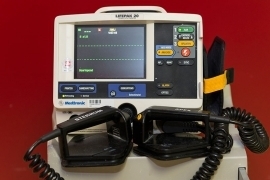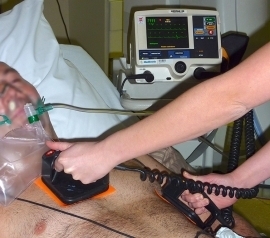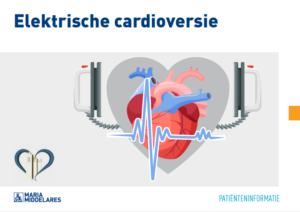Electrical cardioversion
What is it?
What is it?Electrical cardioversion is used to stop an abnormal rhythm (usually atrial fibrillation) and reset it to a normal sinus rhythm.

What is the process?
What is the process?Preparation
You will be admitted to the day hospital. You need to have fasted before admission. This means only clear liquids (e.g. only water, tea, and coffee) for a minimum of two hours beforehand. You may eat a light meal and consume dairy products no later than of six hours beforehand, and a normal meal no later than eight hours before admission. Medication may be taken as agreed with the physician.
Sometimes, blood samples will be collected. You will be given a gown to wear and the nurse will place an IV line in your arm to administer medication later.
The procedure is performed in the cardiac catheterisation room or in the Cardiac Care Unit.

Procedure
Three to six adhesive electrodes are applied to monitor the heart rhythm. The cuff of a blood pressure monitor will be placed around your arm. This will enable us to monitor you closely during the procedure.
You will not feel anything during the procedure. The anaesthetist administers the anaesthetic via the IV line. You will get oxygen through a mask. While asleep, an electrical shock of up to 360 J will be applied through a defibrillator to restore the heart rhythm. Two gel sheets are placed on the chest to protect the skin.
Aftercare
You will wake up after a few minutes after the cardioversion. For the first hour, the stability of your heart rhythm will be monitored through the monitor. After that you will be given a light meal and you may return home. Please ensure that there is somebody who can support you, as you are not allowed to drive a vehicle yourself on the day.
To maintain the sinus rhythm, additional medication may be prescribed.
What are the risks?
What are the risks?Heart rhythm disturbances may result in the formation of clots in the heart. If these clots block small blood vessels they may cause heart or brain infarctions. To reduce this risk, you will be started on blood thinners. Additionally, an echocardiography through the oesophagus can be performed to check for clots in the heart. The latter can be done during or prior to the anaesthesia. The risk of complications is lower than 0.5%.
Skin irritation or limited skin burns may occur at the location of the contact points. An anti-inflammatory ointment can alleviate this.
Results
ResultsYour physician or nurse will tell you immediately after the procedure if it was successful. Cardioversion is successful in 95% of cases.
Leaflet
LeafletSee the leaflet below for more information.
Only available in Dutch:

Elektrische cardioversie
DownloadCentres and specialist areas
Centres and specialist areas
Latest publication date: 16/05/2024
Supervising author: Dr Provenier Frank



